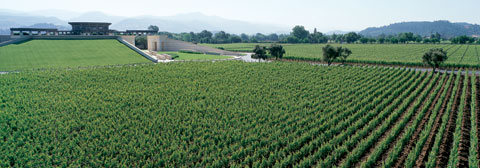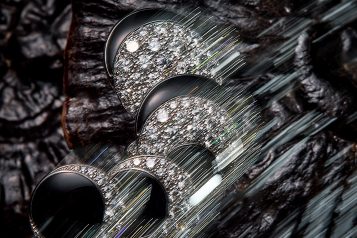Opus One’s enduring legacy continues to produce exceptional vintages from the world’s most expensive single product facility
By Letitia Rodriguez
Opus One, named as such after original partners (Philippe and Robert) agreed to a name of Latin origin in hopes of creating a globally recognizable name, became America’s first premium wine back in 1985 when they established the category of wine priced at $50 and above per bottle.
A simple philosophy: produce an extraordinary wine. That has been the mantra of Opus One since 1979, when the initial collaboration between wine virtuoso Baron Philippe de Rothschild (son of famed Henri de Rothschild, founder of the historical Château Mouton Rothschild) and pioneering connoisseur Robert Mondavi took place.
After initially meeting in Hawaii eight years prior, it wasn’t long before the two hit the pavement to start a joint venture of their own vision, which would include becoming one of the world’s most expensive single-product wine facilities. Not convinced? Well, in 1981 a single case of their wine sold for $24,000 during Napa Valley Vintners Association’s first benefit auction-the highest price ever paid for a California wine.
Nowadays, you can find Opus One’s winemaker Michael Silacci justifying the hefty price tags by producing 300,000 bottles of wine that meet the standards of perfection, not just excellence. The reasons go beyond the cachet of the Rothschild name combined with the forging reputation of the Mondavi family. Opus One is meticulously ‘hand massaged,’ with frequent topping of barrels and six rackings during its 18 months in the barrel, making it extremely labor intensive. The wine is moved only by the gentle force of gravity-mechanical pumps are banned. In the first-growth tradition, the $900 French barrels are never reused. And, at a cost of more than $29 million, the Opus One Winery still lives up to its rank as one of the world’s most expensive single-product facilities.
Opus One created its own market niche as the first, true ultra-premium wine when it was launched in 1984. Before its introduction, there existed a void in this category, not only in the United States, but also around the world. Today Opus One still dominates, at least among American wines. Given the fact that at 25,000 cases (up from the inaugural 20,000 cases) it’s not an impossible-to-find wine, its mastery is its crowning achievement. And while Opus One is a Cabernet Sauvignon-based wine, the addition of other Bordeaux varieties in the blend contributes to appreciable fine distinctions and complexity. The usual components in each case include Cabernet Franc and/or Merlot, with Malbec first showing up in 1994, and Petit Verdot making its debut with the 1997 vintage.
Opus One, named as such after original partners (Philippe and Robert) agreed to a name of Latin origin in hopes of creating a globally recognizable name, became America’s first premium wine back in 1985 when they established the category of wine priced at $50 and above per bottle. However shortly after gaining momentous popularity, Baron Philippe de Rothschild died at age 85 in 1988 before being able to see the completion of his winery in 1991 and the success that the company has now. It was then that the business was taken over by his daughter and only child, Baroness Philippine de Rothschild. By this time there was much to celebrate, as their highly anticipated winery had completed its construction and Robert Mondavi would share his first harvest with new partner Philippine, along with his family.
Between 1999 and 2001, there were a slew of events taking place for Opus One, as they celebrated both their 20th anniversary and 20th vintage, with vertical wine tastings and galas from New York to Paris, and London to Tokyo. All this success led to a great new partnership when Constellation Brands, Inc. purchased the Robert Mondavi Corporation, thus assuming half ownership of Opus One.
Before Baron Philippe and Robert Mondavi were depicted as profiled heads on the new Opus One label, the Rothschild name was already well-established. More than 150 years ago, it was Baron Nathaniel de Rothschild who purchased the legendary Château Mouton Rothschild, previously named Château Brane-Mouton, for 1,125,000 gold francs. It wasn’t long before his great-grandson, Philippe, would come onboard to start reaping what he sowed. With the classic estate now in the hands of a more modern and ambitious personality, the Château was sure to take leaps and bounds into unrivaled success. His first initiative was to introduce Château bottling. He later built the famously majestic Grand Chai, which is a 100-meter cellar spanning the length of the semi-circular estate with over 1000 barrels. Of course there is no such thing as success without acquisition, which is exactly what he did, purchasing the neighboring estates, Château Mouton d’Armailhacq and Château Clerc Milon.
In celebration of the winery’s 20th anniversary back in 2001, the Mondavi family and the baroness threw a two-day party in October that lay to shame any social event Napa Valley has ever seen. Lavish does not even begin to describe the scope of the celebration, centered around a gala reception for 650 guests at the Oakville winery, followed the next night by an extraordinary black tie dinner-dance for 240 guests at the winery. The night featured a congratulatory message from President Clinton, and a message from French President Jacques Chirac was read by André Parant, the French Consul General based in San Francisco. Later in the year, even more grandiose celebrations took place in New York, Paris and London. San Francisco-based event designer Joe Cunningham tented 10,000 square feet of the winery’s parking lot in glittering opulence to accommodate the glamorous crowd, a fascinating mix of celebrities, politicos, and Napa Valley’s winemaking elite.
Opus One has come very far since releasing their first vintage in 1979, becoming a treasured bottle in oenophiles’ wine cellars. Their vintages are a true celebration of unmatched distinction in the wine industry.





















